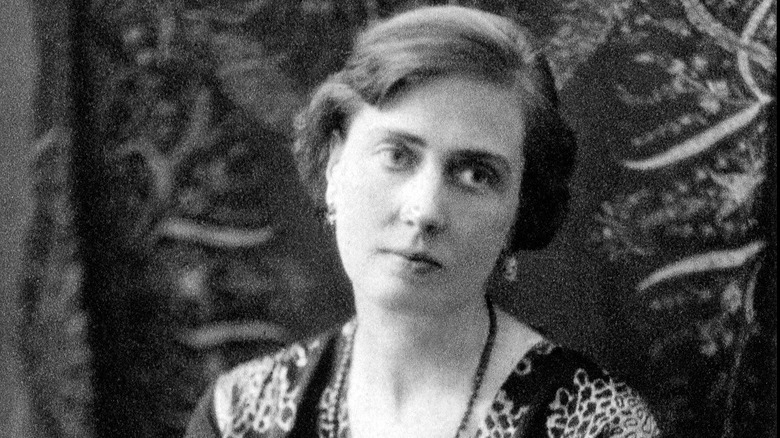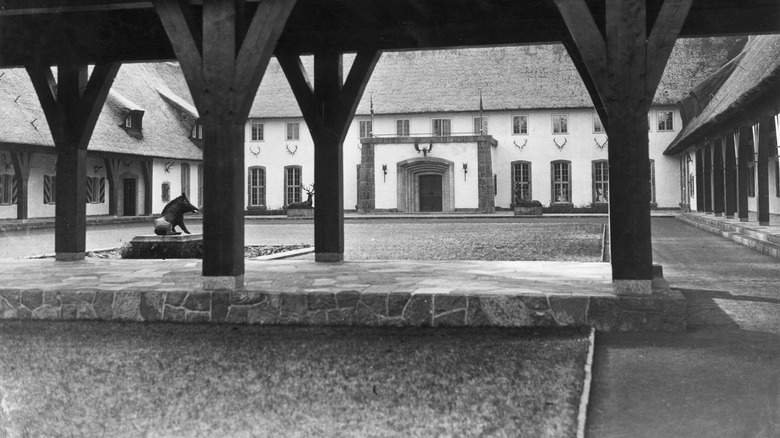The Time A Group Of Treasure Hunters Discovered The Remains Of A Nazi Official's Wife In The 1990s
According to the Holocaust Encyclopedia, Hermann Göring (also spelled Goering) was an infamous figure in Nazi Germany and one of Adolf Hitler's right-hand men. The publication states that he ordered the "final solution" or the mass murder of Europe's Jewish population. However, the 2019 book "Hermann Goering: An Assessment" by Jan Young notes that Göring was a committed husband to his first wife, Swedish Baroness Carin von Kantzow. The article "An Analysis of the Alleged Skeletal Remains of Carin Göring," published in the journal PLoS One, states that the pair met in 1920. At the time, Carin was married and had a son.
Carin eventually divorced her husband and married Göring on February 3, 1923 (per Britannica). By all accounts, Carin was dedicated to Hitler and Nazism. At one of Hitler's rallies, she said (via "Hermann Goering: An Assessment"), "I'm for that man body and soul." Furthermore, the book "Nazi Wives" by James Wyllie reports that Carin nursed Göring back to health after a mental breakdown. She ensured that her husband remained in Hitler's good graces, and much of Göring's success in the Nazi party is attributed to her (via The History Reader).
"An Analysis of the Alleged Skeletal Remains of Carin Göring" writes that Carin had heart and health problems. She died in October 1931 of heart failure. Sixty years later, treasure hunters found her remains near Berlin (per Live Science).
If you or someone you know needs help with mental health, please contact the Crisis Text Line by texting HOME to 741741, call the National Alliance on Mental Illness helpline at 1-800-950-NAMI (6264), or visit the National Institute of Mental Health website.
Herman Göring moved his first wife's remains
"An Analysis of the Alleged Skeletal Remains of Carin Göring" (via PLoS One) states that Carin Göring was buried in her native Sweden. Per Hermann Goering: An Assessment, Hermann Göring was devastated by her death and even more so when someone vandalized her grave in 1933. As a result, he opted to move her remains from Sweden to his grand estate Carinhall in June 1934 (per Bridgeman Images), which he named after her. According to The Guardian, the former site of Carinhall lies in the Schorfheide forest, 50 miles from Berlin. Göring built a new tomb for his beloved Carin and placed her old coffin in a new one made of zinc and tin.
At the end of World War II in 1945, The Guardian writes that Göring had Carinhall destroyed. "An Analysis of the Alleged Skeletal Remains of Carin Göring" reports that he made this decision because he did not want his enemies to get ahold of his possessions. Hermann Göring died by suicide in 1946 (via History).
What, then, happened to Carin's body? Science Codex explains that in 1951, skeletal remains thought to have been Carin's were discovered near what used to be Carinhall. The Swedish Church in Berlin gave the remains to her family, who cremated and reburied her in Sweden (via "An Analysis of the Alleged Skeletal Remains of Carin Göring"). However, the story doesn't end here.
If you or anyone you know is having suicidal thoughts, please call the National Suicide Prevention Lifeline by dialing 988 or by calling 1-800-273-TALK (8255).
DNA confirmed the remains belonged to Carin Göring
The Daily Mail notes that Carinhall's former grounds became a popular destination for treasure hunters hoping to find remnants of Hermann Göring's belongings. In 1991, "An Analysis of the Alleged Skeletal Remains of Carin Göring" (via PLoS One) writes that treasure hunters got more than they bargained for when they came across a zinc coffin with skeletal remains. Although Carin Göring's family supposedly buried her in Sweden, researchers questioned if the remains could be hers. As a result, the remains were given to the Swedish church in Berlin and then transferred to the Swedish National Board of Forensic Medicine.
For unclear reasons, the remains ended up at Sweden's Uppsala University in 2009 (per An Analysis of the Alleged Skeletal Remains of Carin Göring). However, researchers did not correctly identify them until 2012. According to Science Codex, the Stockholm University osteoarchaeological research laboratory analyzed the bones and DNA and deduced that they belonged to a woman. Furthermore, Seeker states that they also compared the mitochondrial DNA of the remains with Carin's son from her first marriage, and there was a match. The researchers announced (via Science Codex), "The results of our anthropological and genetic analyses, together with historical data, provide several pieces of evidence in the identification of the remains of the former Nazi leader Hermann Göring's wife, Carin Göring." Seeker reports that Carin was reburied in Sweden.


